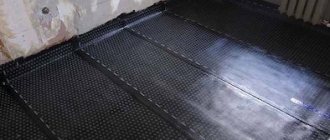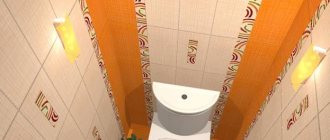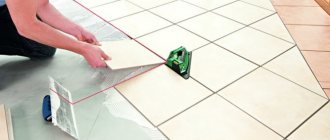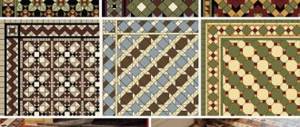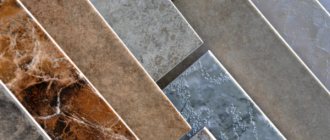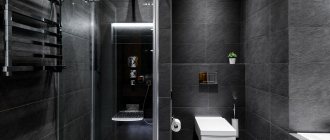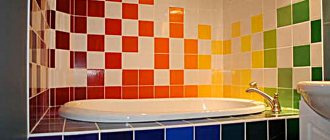By visiting the nearest construction market, you can see a huge number of different tiles, each with its own features and characteristics. And in order not to get confused in the entire range and choose exactly the one that suits your apartment, you need to have a general idea of what types of floor tiles there are.
Ceramic floor tiles are divided according to their type of application. Taking into account this parameter, the described finishing can be divided into floor and wall. Ceramics itself has six main characteristics:
- Durability level.
- Tile size.
- Color.
- Moisture absorption level.
- Tile shape.
- Tile relief.
Classification of tiles by manufacturing method
When studying the types of ceramic products, what immediately catches your eye is that all of its types differ in their manufacturing techniques. Tiles can be made using one of four main methods:
- casting;
- cutting;
- extrusion;
- pressing.
The casting technique involves rolling out a mass of clay of a special composition into special shapes, which then undergo heat treatment. This method is considered the most ancient, and is gradually being forced out of production due to the fact that the edges of the finished tiles are not symmetrical and require additional polishing.
Tiles can also be made by cutting natural stone. This method is considered the most expensive and, accordingly, such tiles are more expensive.
If the extrusion method was taken as the basis for production, then the clay mask is pulled out and then rolled out on a special machine.
Another technique for creating tiles involves pressing. This method is considered the most common due to its manufacturability. The products obtained in this way are extremely durable and have a beautiful aesthetic shape.
Metlakh tiles
If you are unable to choose a specific type of floor tile to purchase. We need to pay attention to the universal type of cladding called “metlakh”, which came to us from Germany. In the CIS countries, this type of finishing is usually called small-format floor tiles. It is made from colored porcelain products. It is based on refractory clay, which can be subjected to strong heat treatment at 1300 °C.
Types of tiles depending on the coating
The modern building materials market offers a huge selection of ceramic floor tiles, including tiles with an unglazed or glazed surface. The first type has a uniform structure throughout almost its entire thickness and cannot have a decorative pattern.
In turn, glazed tiles have a small top layer, which has the appearance of a glassy structure. This layer creates a beautiful effect that gives the tiles gloss, individual pattern and color. Also, the glazed surface is characterized by simple mechanical properties such as moisture resistance and rigidity.
Technical characteristics and properties of floor tiles
The main physical and mechanical properties of ceramic products are specified in GOST 6787-2001. Before purchasing a floor covering, you need to pay attention to the appropriate markings, and not choose based only on the aesthetics of the design. The most important indicator is abrasion, which is sometimes referred to as wear resistance. Even when laying tiles is carried out in a room with low traffic, you need to opt for class 3 abrasive abrasion. These tips apply to bathrooms and kitchens.
Interesting article on the topic: Waterproofing under tiles in the bathroom: is it necessary and what is it?
If you need to lay tiles in a hallway or a passerby, you should opt for class 5 or 4 floor tiles. This tile is also ideal for shops and cafes where there is a lot of traffic. Also, when choosing porcelain tiles for the floor, you need to pay attention to the frost resistance of the tiles. This indicator is important if the floor will be laid in a cold room, for example:
- in the garage;
- in the barn;
- in stock.
Selecting tile size
You should choose the dimensions of tiles for walls and floors not only by their appearance, but also by how convenient it is to work with them. For example, large tiles are difficult to install. It's heavy, but that's not the main thing. A larger plane is more difficult to set in the desired position. It requires a perfectly flat base so that after applying an even layer of glue you can immediately lay it almost flat, and making small adjustments is no longer a problem.
Large tiles are harder to work with, but they look good in spacious rooms
With small tiles, another problem is that there are a lot of seams. Even if there are crosses, keeping them absolutely straight without experience is problematic. Because of this, laying small tiles moves more slowly. Therefore, the most popular sizes are medium. They are easy to work with even for those who decide to lay tiles on walls or floors with their own hands for the first time. For small rooms, from an aesthetic point of view, a medium or small finish is optimal, while a large finish looks more organic in a spacious room.
Related article: How to get rid of small midges in an apartment
Chemical resistance and frost resistance of floor tiles
The degree of frost resistance of a tile depends on the porosity of the product, which in turn is determined by the degree of moisture absorption. Tile has frost-resistant characteristics if its moisture absorption coefficient is not lower than 3-4%. This property directly affects the cost of the product. Therefore, tiles for covering the bottom and walls of swimming pools in particular are very expensive.
Expert opinion
Anton Makarov
Expert of our site. She has been selling and installing floor coverings for over 7 years. Can give really valuable advice.
Ask a Question
When choosing ceramic tiles for a bath, you need to pay attention to the chemical resistance of the material. This parameter is important for rooms where cleaning using cleaning products needs to be done very often. The maximum indicator is indicated by the combination of letters “AA”. Tiles with this characteristic can be laid not only in the bathroom and kitchen, but also in hospitals and kindergartens.
Choosing tiles for the bathroom
The bathroom, due to its purpose, is the wettest room.
Therefore, it is recommended to cover not only the floor, but also the walls. Types of bathroom tiles must have a water absorption class of 3%. When purchasing ceramic tiles for tiling a bathroom, you need to take into account:
- It is better to cover the floor with a product with a matte texture to prevent slipping;
- It is better to cover the walls with tiles with a glossy texture; they are of very high quality. This is also necessary to reduce contact with water and ensure ease of cleaning;
- A good option for finishing a bathtub could be tiles with a marble pattern; they fit harmoniously into the interior of the room. It is also a good option to create a palette that will gradually change color from ceiling to floor, for example, from blue to light blue.
Types of ceramic tiles by type of purpose and operating conditions
The facing material is also distinguished by purpose and the following types of ceramic tiles are distinguished:
- Cladding of internal walls in the kitchen, bathroom and bedroom, office, retail space.
- Floor covering both in residential premises and commercial facilities (shops, hotels, airports).
- Cladding of facades, terraces, stairs, paths, swimming pools and other objects with constant external exposure
- Cladding of stoves, fireplaces, sauna or bathhouse rooms, as well as other surfaces exposed to high temperatures.
Ceramic floor tiles: main types
Floor products are marked with the image of a shoe sole. You should choose the type of ceramic floor tiles based on the following characteristics:
- Wear resistance. Class 2 is suitable for flooring. The second class is intended for non-residential or low-traffic premises, the third - for a house or apartment, the fourth and fifth - for public places with regular traffic.
- Water absorption. The norm for floor tiles is 3-8%. In residential areas with low humidity, tiles with a water absorption of up to 15% are suitable, in bathrooms and kitchens - up to 6-8%.
- Slippery. The optimal type of floor tile is with level R9-10, which is suitable for a living room, corridor, kitchen. For the bathroom, it is better to choose a slipperiness level of R11-12.
Ceramic wall tiles
Ceramic wall tiles are marked with the image of a hand. It is necessary to select products based on the following features:
- Wear resistance. The walls are not subject to mechanical load, so you can choose any wear resistance class.
- Water absorption. For standard premises (residential and commercial rooms) water resistance does not matter. In rooms with high humidity (kitchens, bathrooms, saunas, swimming pools), you should choose tiles with water absorption up to 8-10%.
Choosing tiles for the kitchen
For the most part, in the kitchen, ceramics are used to decorate the cooking area and flooring. For the work area you need
be guided by the characteristics of chemical resistance and moisture absorption because it is this surface that will most often come into contact with moisture and various cleaning agents.
Floor tiles should have their basic characteristics, but have a matte texture to prevent slipping.
When purchasing ceramic tiles for kitchen tiling, you need to take into account:
- tiles in brown shades in the form of a carpet or laminate best hide dirt;
- you need to buy the tile that will best match any color scheme of the interior. White color is neutral and the best option.
Choosing tiles for the corridor
A good option for a corridor would be durable embossed ceramics, which will be indifferent to chemicals and water. Another important factor is what size the tiles will be, since the corridor is a room with frequent traffic, you need to choose wide tiles in the form of a honeycomb or in the form of pebbles. Its advantage is that cladding does not take much time, and its large dimensions create fewer seams where debris and dirt can get in.
Interesting article on the topic: Types and characteristics of ceramic tiles
When purchasing ceramic tiles for corridor cladding, you need to take into account:
- a good tile should be resistant to abrasion and impact;
- The floor in the hallway is a collection of garbage from the street, and therefore it must be cleaned regularly. You need to choose ceramics with maximum resistance to chemicals;
- You should also not forget about the slip indicator. For hallway tiles it should be equal to R10-R11, and the friction coefficient should not be lower than 0.75.
Dimensions of ceramic tiles for walls
For wall decoration, tiles are produced in two formats: rectangular and square. The rectangular one can be placed with the long side vertically or horizontally. The effect is different. Tiles that are elongated upward visually make the room taller, while tiles placed horizontally make the room wider. Both types can vary in size from small to large.
There are several standard sizes:
- rectangular wall tiles: 200*300 mm; 250*400 mm; 250*500 mm;
- square wall: 100-100 mm, 150*150 mm, 200*200 mm.
Types and sizes of wall tiles
But there are a lot of non-standard tile sizes. For example, there is a large square one for walls - up to 400*400 mm. Or long and narrow rectangular - 100*300 mm, 200*500 mm or 200*600 mm. These tile sizes are usually not found in mass collections. When purchasing non-standard options, always take with some reserve: designer collections are produced in small editions. If there is a need to replace broken tiles, they may no longer be available for sale.
The thickness of wall tiles is from 4 mm to 9 mm. Very thin, suitable for lightly loaded rooms. The thickest is most often used for exterior wall decoration. The optimal thickness of tiles for bathroom and kitchen walls is average - from 6-8 mm.
Differences in tiles by type of production and water absorption
There are several types of tiles; they differ from each other both externally and technically. But there is another criterion by which tiles are classified - the method of its production. Other market offerings include majolica. This is a tile based on red clay containing large pores. The tile is covered with a special opaque varnish, on top of which a pattern is subsequently applied.
Taking into account the types of ceramic tiles, pay attention to the degree of their water absorption. Majolica absorbs up to 25% water. Ceramic products have rounded shapes and are distinguished by their durability. The products are recommended for use on interior walls where the humidity level is relatively low.
Also among the offers there is white ceramics, in other words – earthenware. Its main component is white clay. The outer side of the tile is covered with a special varnish. Based on production technologies and materials, earthenware is compared with porcelain.
A product such as earthenware is produced by firing in two stages. Its water absorption is 20%. It is recommended to use tiles in dry conditions. If you are interested in ceramic tiles for walls, then consider Cottoforte. This is a pressed tile, made by double firing, and the front side is covered with a special opaque varnish. The product is highly durable, this is due to the composition of the tile. The tiles contain 3 types of clay. Water absorption ranges from 7 to 15%. Cotto is installed on indoor floors.
The main component of the cottoforte product is red clay. During manufacturing, the product goes through one firing stage. The outer and inner sides are treated with brushes designed for tiles. Brushes contribute to the formation of a bumpy surface. Cottoforte is used for floors inside buildings, sometimes for finishing on the street side. Water absorption ranges from 3 to 15%.
For floor
Thick ceramic tiles with a hard protective coating or porcelain stoneware are placed on the floor. It comes in form:
- square (standard tile sizes 200*200 mm, 300*300 mm, 330*330 mm, 350*350 mm, 400*400 mm, 450*450 mm);
- rectangular (100*200 mm, 150*300 mm, 200*300 mm, 300*400 mm);
- multifaceted (pentamental, hexagonal and octagonal).
In addition to these sizes, there are non-standard ones: smaller and larger. The largest floor can have a side of 600 mm, and rectangles can be 20 * 600 mm or even longer. Usually such long and narrow ones imitate a wooden surface.
The most common types of floor tiles are square and rectangular
The thickness of ceramic floor tiles in the standard version is from 8 mm to 11 mm, but there are increased strength ones - up to 25 mm. For private houses, they are used extremely rarely, except to lay out the floor in a garage or on a parking lot, under a carport. In general, where high coating strength is needed.
Another type of tile for flooring is porcelain stoneware. It is mainly produced in squares, and more often in larger ones. Standard sizes of porcelain tiles are 200*200 mm, 300*300 mm, 400*400 mm, 450*450 mm, 600*600 mm. If there are rectangular ones, then they are long and narrow: 60*120 mm is the standard and also comes in the following sizes: 200*400 mm, 200*500 mm, 195*600 mm, 200*800 mm, 200*1200 mm, 300* 1200 mm, 400*800 mm, 445*900 mm.
Porcelain tiles - polished or not
The standard thickness of porcelain stoneware is from 8 mm to 14 mm, but there is a thin one - from 4 mm to 8 mm. Thin porcelain tiles are usually laid in technical rooms of apartments or private houses. The load here is small and the material is strong enough to withstand it.
Technical characteristics of floor tiles
Having become familiar with the types of ceramic tiles for kitchen decoration, which are classified according to the same criteria, you can understand that the resistance to bending will be greater, the less water absorption. This can be seen in the example of ceramic granite; its resistance is high, and water absorption is 0.5%. And if we compare large-pored tiles, then their bending resistance is low, and water absorption is 10%, in some cases 15%.
Porosity, hardness and durability
Porous raw materials are produced by firing in one stage. The strength of the tile directly depends on the thickness: the higher its value, the stronger it will be. If you are considering exclusively ceramic tiles and their characteristics, then you should pay attention to the fact that this cladding also differs in mechanical characteristics. The shelf life of tiles depends on the degree of surface hardness and durability.
The degree of hardness is determined by attempting to damage the surface by scratching it with a natural mineral. The hardness of a tile is indicated by a number that is the previous number on the mineral scale that was used to scratch the surface. There is a special scale on which minerals are arranged in a certain sequence, depending on their hardness. This scale is called the Mohs scale. The first cell of the table contains talc, and the last cell contains diamond.
Interesting article on the topic: Cutting tiles: instructions for DIY enthusiasts
The hardness index depends on the type of tile surface. A minor scratch will be clearly visible on a varnish surface, unlike a matte one. It follows from this that it is better not to place tiles with a varnished surface in places where there is severe wear. There are types of ceramic floor tiles on the supply market, which can be grouped by durability. The abrasion resistance of tiles is something that is worth paying attention to almost in the first place. Tile for residential premises will meet some requirements, and completely different ones for public places.
Floor tile designation table
Varieties of Volgograd tiles
If you are determined to purchase wear-resistant tiles, but are counting on a relatively low price, then take into account the abrasion resistance indicator of the front side. Based on this indicator, it is possible to classify the types of Volgograd ceramic tiles. The tile may belong to the PEI I group, this indicates that the tile is intended for places with low human activity. If the tile bears the PEI II mark, this means that it can be safely laid in crowded areas where people wear house shoes.
For intermediate intensity and long-term use, PEI III tiles are intended. If the product is selected for a hotel or other place with similar activity of people, then it is better to purchase PEI IV cladding. The most stable product is considered to be tile with a PEI V rating. It is usually used in areas with high traffic intensity.
Optimal thickness of tiles for walls and floors
Before we talk about the thickness of the tiles, let us remember that finishing materials for cladding walls and floors in a room are divided into two large groups:
- Ceramic tile;
- Porcelain tiles.
Tiles are more often used for wall cladding. Porcelain tiles, due to their high strength, which brings them closer to stone, are used to cover floors.
Since the general technology for the production of tiles and porcelain stoneware is the same for all manufacturers, we can talk about the optimal or common thickness of these materials. The thickness of the tiles on the wall is 7-8 mm, the thickness of porcelain stoneware is 10-11 mm. The minimum thickness of floor tiles is 8 mm.
Note: Small tiles with a thickness of 3-4-5 mm are available on sale. It requires very good preparation of the walls and very careful installation, so it is not popular among professionals.
The specified thicknesses are optimal for production, packaging, transportation and installation. However, you need to understand that the larger the size of the tile, the greater the thickness it can have.
For example, Kerama Marazzi tiles, TRIANON collection, for walls measuring 750x250 mm, have a thickness of 9 mm. The same collection for the floor has dimensions of 502x502 mm with a thickness of 9.5 mm.
With an increase in the thickness of the tiles and their sizes, the laying technology and the choice of tile adhesive change somewhat. This is especially true for walls, as there is a creeping effect.
Related articles: Sections for fencing
It is worth noting that porcelain stoneware manufacturers have found a compromise between increasing the size of the tile and increasing its thickness. They produced very large porcelain stoneware, so-called slabs. Their length reaches 3 meters, while the thickness is in the range of 3.5-5.5 mm.
Advantages and disadvantages of floor tiles
Floor tiles are one of the most popular flooring options. And, like any coating, it has its advantages:
- wear resistance. If you choose the right coating, the tiles will not lose their beautiful appearance even after long-term use. And some ceramic products can last up to 50 years;
- strength. The strength of some tiles can easily bypass concrete;
- huge design space. There are thousands of patterns and colors of floor ceramics, from stone tiles to tiles with abstract patterns. You can easily choose something that will fit perfectly into the interior;
- moisture resistance. Tiles with minimal porosity are able to perfectly withstand moisture;
- fire resistance. Ceramics, unlike wood-laminated surfaces, is completely fireproof and can conduct heat well;
- hygiene. Fungi or mold cannot form on the surface of ceramics;
- hypoallergenic. The floor tiles contain no harmful substances.
But there are also several disadvantages:
- poor sound insulation. Any movement on the tiles will be clearly heard throughout the house;
- high price. High-quality products will cost a tidy sum.
Mosaic
This type of finishing material is usually classified as a separate category, since it has many specific features and properties. These are pieces of ceramics, glass, porcelain stoneware or natural stone mounted on a mesh. Can be used both for finishing floors and walls. It is especially good on curved structures - thanks to its small fragments it fits onto surfaces of any curvature.
Mosaic is a very original finishing material
The tiles used in the mosaic are square, with sides ranging from 10 to 50 mm. Much less common are those consisting of rectangles, polyhedrons or round shapes. These are designer collections and the sizes can be very different, but usually within the same range of 1-5 cm.
The thickness of the mosaic is from 2 mm to 12 mm. Thinner ones are usually ceramics and glass. They are often used to decorate walls. For laying on the floor, thicker material is used - it is more resistant to abrasion. There may already be porcelain stoneware and stone, and the thickness is 5 mm or more.
Video on choosing floor tiles
Viewed times: 1,659
Great article 1
Author's rating
Author of the article
Oleg Grishin
Flooring specialist with 10 years of experience. Oleg has something to share with our readers
Articles written
103
- Even more interesting:
- Types and characteristics of ceramic tiles
- How to lay metlakh tiles yourself?
- Painting floor tiles: a new look without much effort
